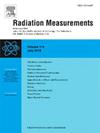Radiation source analysis of beamline stations at fourth-generation synchrotron light facility
IF 2.2
3区 物理与天体物理
Q2 NUCLEAR SCIENCE & TECHNOLOGY
引用次数: 0
Abstract
Bremsstrahlung produced by electrons in the storage ring is a major concern in the radiation shielding design of synchrotron light sources, primarily arising from the Touschek effect and vacuum-related effect. Depending on the underlying mechanism, the resulting bremsstrahlung is classified as either solid or gas bremsstrahlung, both of which can propagate into beamline stations, especially from straight sections, thereby posing radiological risks to personnel and equipment.
With the advancement of fourth-generation synchrotron light sources based on diffraction-limited storage ring technology, the characteristics of bremsstrahlung radiation originating from straight sections have become increasingly complex, making earlier radiation source models no longer directly applicable. The objective of this study is to conduct an analysis of radiation sources in beamline stations of fourth-generation synchrotron facilities, clarify their respective contributions, and evaluate the implications of different modeling methodologies for shielding design. This study focuses on a representative beamline at the Hefei Advanced Light Facility. Three modeling approaches are developed and compared: (i) a simplified model, which assumes uniform electron losses throughout the storage ring with fixed-angle impacts on internal surfaces; (ii) a more refined model, which uses ELEGANT to accurately simulate electron loss positions and dynamics in straight sections, coupled with FLUKA to analyze the generation and transport of solid bremsstrahlung; and (iii) a gas bremsstrahlung model, which employs FLUKA to directly simulate electron–residual gas interactions.
The study compares the energy spectra, angular distributions, and spatial profiles of bremsstrahlung from the three models on the upstream wall of the first optical enclosure. Ambient dose equivalent distributions surrounding the enclosure are also evaluated. Results indicate that both solid and gas bremsstrahlung are major contributors to radiation levels in the beamline stations, each exhibiting distinct spatial and spectral characteristics. In addition, the study finds that the simplified model introduces significant deviations in the estimation of solid bremsstrahlung, highlighting the importance of accurately incorporating electron loss information in radiation simulations for beamline stations at fourth-generation synchrotron light sources to achieve reliable shielding assessments.
第四代同步加速器光束线站辐射源分析
存储环中电子产生的轫致辐射是同步加速器光源辐射屏蔽设计中的一个重要问题,主要是由于图谢克效应和真空相关效应引起的。根据潜在的机制,产生的轫致辐射分为固体或气体轫致辐射,这两种轫致辐射都可以传播到束线站,特别是从直线段传播,从而对人员和设备构成辐射风险。随着基于限衍射存储环技术的第四代同步加速器光源的发展,源自直线截面的轫致辐射特性变得越来越复杂,使得早期的辐射源模型不再直接适用。本研究的目的是对第四代同步加速器设施光束线站的辐射源进行分析,阐明其各自的贡献,并评估不同建模方法对屏蔽设计的影响。本研究的重点是合肥先进光设施具有代表性的光束线。本文提出并比较了三种建模方法:(i)简化模型,该模型假设整个存储环的电子损失均匀,内表面受到固定角度的冲击;(ii)更精细的模型,使用ELEGANT精确模拟直线段的电子损失位置和动力学,结合FLUKA分析固体轫致辐射的产生和输运;(iii)气体轫致模型,采用FLUKA直接模拟电子-残余气体相互作用。研究比较了三种模型在第一光学罩上游壁面上轫致辐射的能谱、角分布和空间分布。还评估了围体周围的环境剂量当量分布。结果表明,固体轫致和气体轫致都是影响光束线站辐射水平的主要因素,并表现出不同的空间和光谱特征。此外,研究发现,简化模型在估计固体轫致辐射时引入了显著偏差,突出了在第四代同步加速器光源光束线站的辐射模拟中准确纳入电子损失信息以实现可靠屏蔽评估的重要性。
本文章由计算机程序翻译,如有差异,请以英文原文为准。
求助全文
约1分钟内获得全文
求助全文
来源期刊

Radiation Measurements
工程技术-核科学技术
CiteScore
4.10
自引率
20.00%
发文量
116
审稿时长
48 days
期刊介绍:
The journal seeks to publish papers that present advances in the following areas: spontaneous and stimulated luminescence (including scintillating materials, thermoluminescence, and optically stimulated luminescence); electron spin resonance of natural and synthetic materials; the physics, design and performance of radiation measurements (including computational modelling such as electronic transport simulations); the novel basic aspects of radiation measurement in medical physics. Studies of energy-transfer phenomena, track physics and microdosimetry are also of interest to the journal.
Applications relevant to the journal, particularly where they present novel detection techniques, novel analytical approaches or novel materials, include: personal dosimetry (including dosimetric quantities, active/electronic and passive monitoring techniques for photon, neutron and charged-particle exposures); environmental dosimetry (including methodological advances and predictive models related to radon, but generally excluding local survey results of radon where the main aim is to establish the radiation risk to populations); cosmic and high-energy radiation measurements (including dosimetry, space radiation effects, and single event upsets); dosimetry-based archaeological and Quaternary dating; dosimetry-based approaches to thermochronometry; accident and retrospective dosimetry (including activation detectors), and dosimetry and measurements related to medical applications.
 求助内容:
求助内容: 应助结果提醒方式:
应助结果提醒方式:


